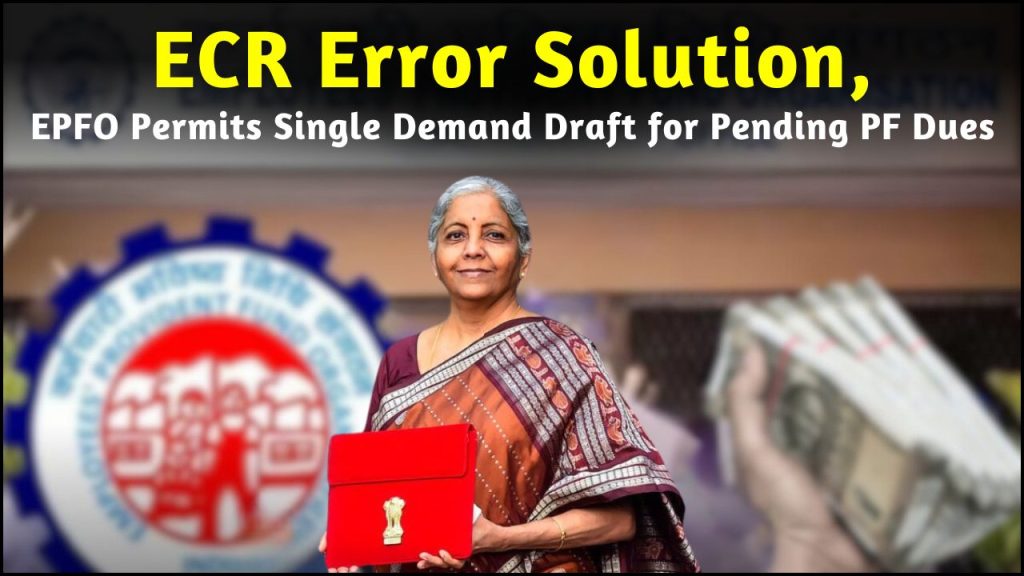
In a move aimed at easing the burden on employers, the Employees’ Provident Fund Organisation (EPFO) has announced a new provision allowing companies to clear pending Provident Fund (PF) dues resulting from Electronic Challan cum Return (ECR) errors through a single consolidated demand draft. This significant update is expected to reduce procedural hurdles and support employers who faced genuine technical or clerical mistakes during the ECR filing process.
Understanding the ECR Error Issue
The ECR, or Electronic Challan cum Return, is a mandatory monthly return submitted by employers to the EPFO. It provides detailed information regarding the contributions made to each employee’s PF account. However, technical glitches, human errors, or mismatches in data often cause discrepancies, resulting in delayed or unsuccessful payments. These issues can lead to compliance complications, penalties, and stress for businesses, especially small and medium enterprises.
Common ECR Challenges Faced by Employers:
- Incorrect UAN (Universal Account Number) entry
- Mismatch between declared wages and actual salary paid
- Delayed filing resulting in additional interest or penalties
- TRRN (Temporary Return Reference Number) mismatches
- System errors causing challan failures
Such errors disrupt the smooth processing of PF contributions, leaving many employers with unresolved dues and notices from the EPFO.
EPFO’s One-Time Demand Draft Facility: A Major Relief
To address the mounting number of unresolved ECR issues, the EPFO has now officially introduced a one-time provision that allows employers to submit a single consolidated demand draft to cover all pending PF dues that arose because of genuine ECR-related mistakes. This step is intended to simplify the payment and reconciliation process, offering much-needed relief for employers struggling with complex PF dues.
Key Features of the Demand Draft Initiative:
- A single demand draft can be used to pay off multiple pending ECR dues.
- Only applicable to genuine cases caused by technical or clerical errors.
- Employers are required to submit a detailed statement of pending dues.
- Prior approval from the respective EPFO field office is mandatory.
- Helps expedite the resolution of long-standing compliance notices.
Benefits for Employers
This facility is particularly beneficial for smaller businesses that may not have dedicated HR or compliance teams. It reduces the complexity of navigating the PF system and helps employers avoid accumulating interest or penalties due to inadvertent delays or mismatches.
Main Advantages:
- A simplified payment mechanism for settling multiple PF dues.
- Reduced administrative workload, especially for SMEs.
- Minimized the risk of legal action or further penalties.
- Improved compliance track record and organizational reputation.
- Opportunity to clear historical dues without multiple transactions.
How can employers avail of This Facility?
Employers wishing to take advantage of this one-time opportunity must follow a clearly outlined process. While the procedure is straightforward, it requires attention to detail and appropriate documentation.
Step-by-Step Process:
- Prepare a list of all pending TRRN numbers and corresponding ECR challans.
- Cross-check dues with bank statements and previous payment records.
- Draft a request letter addressed to the local EPFO office explaining the situation.
- Clearly state the type of error (technical or human) with supporting documents.
- Submit a consolidated demand draft covering the entire outstanding amount.
- Await confirmation and reconciliation from the EPFO office.
Required Documentation
To ensure the application is processed smoothly, employers must submit the following documents:
| Document | Description |
|---|---|
| Cover Letter | Request for approval to submit a single demand draft |
| TRRN List | Complete list of affected ECR submissions |
| Challan Details | Challans linked to each TRRN with error explanation |
| Proof of Payment | Bank statements or transaction receipts |
| Demand Draft | One draft covering the entire outstanding balance |
| Employer Declaration | Statement confirming errors are genuine |
| PF Details | List of affected PF accounts and correct UANs |
| Previous Communication | Any earlier correspondence with EPFO regarding the issue |
Sample Table of ECR Issues
Here’s an example of how employers can compile their data before submitting:
| TRRN Number | Month-Year | Due Amount | Error Type | Status | Remarks | Paid | Final Due |
|---|---|---|---|---|---|---|---|
| 1012456789 | Dec-2023 | ₹15,000 | UAN Mismatch | Not Processed | Name error | ₹0 | ₹15,000 |
| 1019876543 | Jan-2024 | ₹22,500 | Wage Mismatch | Rejected | Partial paid | ₹10,000 | ₹12,500 |
| 1012233445 | Feb-2024 | ₹12,000 | Late Submission | Interest Pending | Delay >10 days | ₹0 | ₹12,000 |
| 1019988776 | Mar-2024 | ₹18,300 | Technical Glitch | Not Recorded | Server error | ₹0 | ₹18,300 |
Who Can Use This Facility?
EPFO has made it clear that this initiative is only for employers who:
- Have genuinely attempted to make timely payments.
- Can prove errors were beyond their control (technical/human).
- Are you ready to clear all outstanding dues in one go?
- Possess complete documentation to support their claims.
This facility is not meant for habitual defaulters or those intentionally avoiding compliance.
EPFO’s Objective Behind the Move
The main goal of this initiative is to:
- Foster trust between employers and the EPFO.
- Reduce compliance fatigue due to recurring procedural issues.
- Resolve long-pending disputes in ECR filings.
- Encourage digital accountability and streamline documentation.
By enabling a one-time correction route, the EPFO hopes to ensure that honest employers are not penalized due to system flaws or minor clerical lapses.
Important Reminders for Employers
- This is a one-time facility, not a recurring option.
- All supporting documents must be accurate and verifiable.
- The demand draft should match the total pending dues exactly.
- Always retain copies of all submissions for future reference.
Final Notes
This step by the EPFO is expected to bring clarity and relief to numerous employers caught in procedural complications. It encourages transparent and timely resolution of ECR-related issues while ensuring the integrity of the PF system remains intact. Employers are encouraged to approach their local EPFO offices with the necessary documentation and make the most of this relief measure.



